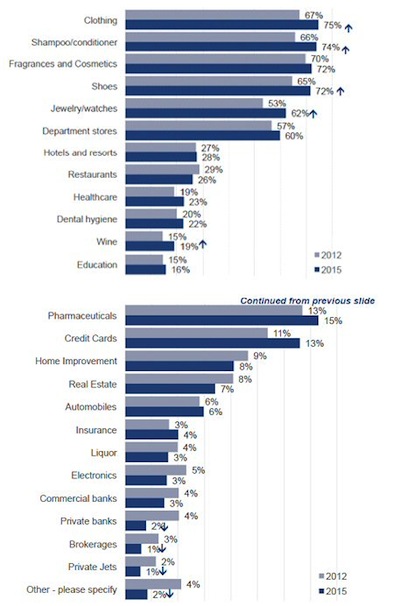Brands in the apparel, personal care and footwear sectors are among the best at marketing to affluent women, according to research by Luxury Institute.
The best industries targeting affluent women through advertising and social media do not come as a surprise, but it does shine a light on the sectors that are not doing well at focusing their attentions on this demographic of wealthy consumers. Survey respondents felt that the industries doing the least to target affluent women include insurance, liquor, consumer electronics, banks and brokerages and transportation including automobiles and private jets.
Luxury Institute surveyed women ranging in age from 21-years-old to more than 65-years-old with a household income minimum of $150,000 per year. The respondent pool’s had a reported average household income of $289,000, and a $2.9 million average net worth.
A battle of the affluent sexes
When it comes to marketing to a female demographic, brands in apparel (75 percent), shampoos and conditioners (74 percent), fragrances and cosmetics (72 percent) and footwear (72 percent) unsurprisingly fared the best.
In regard to the industries that are failing at capitalizing on the purchasing power of affluent women, each had an approval rating of less than 5 percent. This approval rating has continued to fall since 2012.
Efforts put forth by automotive brands, for instance, have only impressed 6 percent of the female respondents. Although traditionally associated with a masculine culture, the auto industry should expand its marketing efforts to cater to the sentiments of its female consumers, especially those with families, by touting the safety of high-end vehicles.
On the corporate side, automakers have made strides in being more inclusive of females in general. For instance, British automaker Aston Martin looked to close the gender gap in engineering by teaming up the Royal Air Force to introduce female students to various career routes (see story).
Sectors improving outreach to female consumers include the jewelry and watch sector, which has seen the largest improvement over the past three years. Sixty-two percent of respondents felt that these brands do a good job marketing to their demographic, a 53 percent increase from 2012.
In addition, department stores are listed sixth, with 60 percent of affluent women appreciating the efforts put forth by retailers.

Graph provided by Luxury Institute
Across the board, older affluent women aged 45-64 felt that brands across industries are doing well when marketing to their demographic. This response was much more likely from the older age group than it was for women 45-years-old and under.
But, 25 percent of women 21- to 44-years-old felt that the wine industry is not doing enough, or not marketing to them well enough. This propensity decreases with age, with 21 percent of 45- to 54-year-olds, 16 percent of those between the ages of 55 and 64 and 12 percent ages 65 or older approve of the wine category’s marketing efforts.
In a statement, Luxury Institute CEO Milton Pedraza said, “Married women tell us that they make two-thirds of all household purchasing decisions. Women maintain huge economic power and it is a necessity for companies to step up marketing and how they connect with affluent women regardless of industry. Research that includes speaking directly with these women about what appeals to them and what turns them off removes much of the guesswork in making marketing decisions.”
{"ct":"gvsxZotpsFIcQa3kn+9ZYNxI7jQXoc8ya4P\/hwl5SPCXTRzK6ZEj80Fr\/vQCudMzfVMVGiNsRbiTsoQhAWbbGp1XiBbVDZ2dliXcTLjc6DHFFfQ9tAwssj1BxSmbIUpcJH0RhmBNkipB\/k9L+X3reoQqYHfMrUa9JVYSv74zd\/1xsb8A0psg\/Ujb1J+6n5nu25ygCXYFEU2PckgQKvDHnyzYAGB7gReph0V7OmUM9UlmpkKyf1\/KFcK3Cl6mBtfXTzRYEKPoCi\/57KB3xTP5b+ikW0J2VqCxbXzi6tO2qO7qVSu3nC8yEyBV8xOSRN4Tvbyh99sRf0P55DSdIJTIhI7\/UYZqiPMrm\/stqc0r75BRGtLeVahgA7ezXnO0Rfv+Gszo+rQgPgHIan8msRCLfu8tKvEcxqGxNEoVrnV8J\/AacXvMkDmyBxmDWF+31FFIZaVQCgsEAh3VAMzUipCGVZX6ixJtUBxzEBDHN3ihjwATQatDEcBH3PkkQRJEYqVNxEEumDI+FcEPX5jttkhhn53Q7ec3fr\/zg7XoFdqQmFd3yTqap+qNeEhJWWE\/xI\/Vvu217vOjfS\/+QsdzHE5Hx5i9p73b\/\/KoF8L+imqDXSXNYwFMpGRA\/ASB1je4l\/92hG1ThhRmuYAKDs0U+h5sjvTOzg9DUG+NVL7MhrbsMo9gR\/9pk49cVfwuIKXUd6WGpycbW+qSiEiUn5DfdZi2\/d8v9PeXkki+dZy7mKX+iCvhsJ8L5\/eoC77yq9OFyayp8yINVM2wyLY1GRr7Epf02w7Uf+EAooQ7SwNCyj6UnUcVj9HfLXxp+sTiZzx\/iIqDipY7a8v8StXS47PJuOdIlfrOws1Kgz9IwfuUKE3Ce6OaPldAhopZb3iNtyMI89Wfw+aBW+4rmS6M8iYiuR1+6F7t1SRACqNW2IJonYfvqU4dem2Cje3JhGHP\/WeSNDQ6IaKEvdPkMlUPi\/g6CXCW3vSAXTKi3rlkTraGp\/WHocw2FsjQnjZknz5Xd8IXFNDAfIQIQracnMkoBn44GAt\/zPJeKR0dMM47xfD9nJLrnb1ra8sTlxJJQmi7yJUkvOm\/HUXOU74+yMePzKXPWmzNV82EMolCFKAdGGDC1d0GL7Y4eyO1QQbASpYFNbmUM2BUC4M70pNGpkB3rTa8okFOLOwbp2m\/UWr1zgVClDUb4uae2dFTI0iwdqX+LGqAC0Oy34Fu0XVv\/PTyunyN81Ib5xnE7GV35SZXyuT68LlmxDvDm0Wosxf+Ng24zCgBRVBOJRzOYIknJUhy1LGYxepC\/i\/jLuACV\/ofC8O9Y3VcK17NBytvkPz4TUzEvwMGBGdyL2CoyvOHUlEOiGxfqF4QTv\/6+JF4AIzfK7GcpE2tNzTIrBeFq8q1O1A+9w\/YJEh5DB6HSdBbFdUiDXA4dAXh8\/YMk5soUSyFFPvLXW2ACyYmvHpoegBb4FnPx6F+uF3nXJZiFOnwy6P8K\/n89GVv+s9neEXQVQFh+4qfDBxpM8TXszY1FyfmPjZC5Yo5liN8QwFVakPGsmawU28Gs9qWV2W9P9v6Vnjy9k8H+V9zbQJVA9ITXj5huSxKjfEQ1gnav+jNo0mO3fq9HufvWeiSASwrKN\/u+IR4ZVYTAcW5gMKTq5bDk4rojxfUv9w\/SM5++1a5YDIIk\/vHRp9Sy9ZkrN7s86tHv2ta2glCixkvTClepggCwlfA4SaseKUnvjMPqfkYa9H7wi4\/\/pxM7L6sycpJ6dJgwFqbHMYVvNZ1dSF68Q\/qFb0I9LqU8WIAT9I3H9I3YmAVcxDTFkktkO668VVAfv+dXSk+9P\/BfrVDJXytnCaDo1jz+Q\/\/jg2LJazE\/GQ0G9yLGkVY9kUHrR3m1DYUo2A+vbExGmwCtBC2Cwa39oiNHVBYREfXy1ZcgspZxcwvdOy3pu+h+zEgIoYCJzlstiKpr7BLWonRrELiOPjLSHdCpw103XsMUBtgSFqRS1yh8KvYEhsk\/pU49bne2O5fcFTGA0N3qKjNcYE6CtZc1ru6sKY3bxiq73snR8l2p3wfr9W9o5nFIbiGGtk9zt5gQH\/skJibqqMnIed3IEDgGtgd1mpPXSAY47iDLUTNgFMAL7wWDDONky6pwSGXddNPv+21ZDqnfJ0KNVyvWGDcFBtkk2NMxAxh2qjAWCElPNuuk\/Y\/vx+zYD\/SCUklodHF07Rg9pXA\/Sl\/Yw6VdIClThA6Ral99sPb51rL2rN78BiIOlPdjj9G0jZu5vtu1dbdZjDhlCsipSmPf6IF1BEOJgC65JvrIwYwsiZqygsbTbcCIn9a7kXrqYXbGcd0THmXsh+Z5wf65FCyIw1Q2p3fiagRlbRArkqwoP5pA4+9WggL57EX9RXhjSxHVD4xUyG+7mmQ0qewQP0SGn+UI5BajhSc7euPtncFW0m24MhNOquIMT+M5VibytrTGt8GRfS3moB5rgJ9mtQWG4EHitykMoPryKKIn7xtyCf4+BWf9lkOj+pzfS53NGz7E5ChBKmapNXfHqkESiIinZMZr+FrI3zZrANRkmuuto5pDXwAQoZjtT9fdn4dy4BeKRCF90fx\/jNf8evTVt9PmGdKBlb1pkyyhN+O0snlecnymRsZjffSmnxmeMKeWAq63eBNxG1OnIBeDpkih7qOg2b+lkNO2mUIHrMs4fA4O6p\/aWR7em8aexJMaEjxPRMGvIl+pRFzG+7NPSHDRwYy9CqTZ352DhOlXScR5QyepOepSjjQyfRaHPppbGbtdFKdz5G1uyxPqRmPtN\/RnHWrQ4iC2UQzFFsBmxzuwhJ5vP38K+KB4ceE18tWOS2T79c006JI4dpiwtWCPbw7JlyTbDdtQ+MGkedkwSf2r3\/+H66oHl8eCA+1o7mitNIeGt9VsagopKEC6+yzuK0a6VKBTJVLQwl\/FsUV6l+k+1eacGoRHKpptYLokSkFEptkL116c\/LnulhUw2\/19g4h8aCjtTtChu2tglGJk5ofgF8EN2RPXUZzjo9UBPpl9ktDdx\/b\/Iw59HU3QkSs8Fprt37hbR6+l3+nn09Vky4hXvfT54LFESEu6xsuu3amUBjYlNMD8wBovOGZZrIr1MhZis0ffMvbkENXauEKdJ64w\/y4jISv8qO8TldUwPs1wqcfW0n8IKtZZSyWBk0+vXJTWMZSR8NewAZPZs0URr8496LvC1+H1n2YpB8tcpTkyK8u7zA8k8YjU38ShgNOJVoKVOUtBt5QDjzFwBr1QtGApHZZLBFOT9MYHbKkn8KYkVhGlK7ZOZiShdrtUF43+0RIo6MsWmzCNHUkLXrRMGfFbWkeqH+wCiCZL9z5PNcTVHvCoU9l5bIGQcp2scti\/asE5Zj2nWmlWiyckznxlFAlyLEp7NmNlovEUUh9jN29UEv72b3bZpHeHHjugMKJ9iOqMQQE9qhXvMQBCA2wDQ3Jq4YuiFeBJjqxgn46gMTI9XusGAi6noKHkH8rIS+tftiMjVb1lHms6uiYmqMKh9RLqDlp402k7RGGxgkALc4ezjQ4g7mkCF\/v+jOwDi8zElil4sf8udCthlww\/6YCoUkocPSTOXo\/KH3M1hz0ww49n8GpVVV\/aHIhftWf9BNA7j7RLa0Z7RbRNmVY2UYlPFR1hOcTAW0b179haxxSFEkedKg0kB7VMbIq\/LnUp+I3hExrfA+h4ddzP1G7nRChFEzYZtecKD22l+4mn9rt28ZMWSjxt\/Szm7Ta4NoG1edK0E4IdkNEuRzItUCAYZcqxz8kg5t64GoQTRRLCushhM8bMGCdfKZqxMA+iMMHZG6\/4ew2vP\/ztzfhqkxCIBCcUwbU5V7IUuaD5FctTwEsJYC2u28zonqh7QU3uvEtnZwIljGPPPgbu7Jt1ic9wOmQfCwaJf6oUNkGezSadbcMyglP3Yant20a\/2Sv4gZPZ1WcVqTNjWMJ9b6RDb0hDxS16QT\/xAZeG959byiU90tJNBvE86i9q+s94fIcUut2V0eLDASwLvhnezR5e5SakkAv99YkjuFUvXjhUgul+SXP8Y1edaEsxdofP0jCTbkp+lFw\/FE46AVlUJIFSObNymSH35ElLiPC7nESo72vFssfNoPYXWX2vAqSXtH0NlpXMfoji5we3bplg4B+sJ5Sl19UwyxHXgWUqXr2jslSm6zfvyhfQ9MIiqsEMypjeB6Igdy9nwcen\/aMba1SVKUqX3EEXHKL6qbFlZkt7sHPw6SLXzXrUk5w1fgPz54gzMxCmXERJ3YSVwPAXFGf\/tVFQtcfrx0rL6FaXMqAQ9fesI0eY9pNgBQwiQZYc+1NZvcRdC2njrybL5OsoVw0SwXJuYqPGQL9SHb7lF46U5aQJzDS+O1ItHvr+cHkfWeUFda0bNuo4zJltIxmzzgkszauxQL1qSAA+M1ThT45RBhQwoGc9UWuEXUs5W+rm+gxp3WS4mxVa8FTyavYSNdWFIaGy7j7VOmvfudvoIYkw8n\/BZu6F9omB5zRczTetedXWnRbwGOGbz7NFRfZcrbw0oG8BRPR32NJjYK2PCxokSyVxZiSmlM+rjfvjlQJyDOza8cmDkiZ3zW6ddG\/v2jAlETWSk+7P0U96LMU93DugxmHc\/pN\/kcoNZcBLJFHt6xpZ1RhArTvNzcKNITlQjA1uCxkq+xvuET3swAWKycgUirudSw4w7IyJLg5ezmP+7oYHHdiI2riyK2RIypEPME54yoz1oFNc9edtrAxl5GeLfdYWuNQWcr9ozXEvPjb45LuH4ZPapSCeyk8Zkthj4Hdz4tFXXIODYLyjOKqZuttBkYachNvWPbn76ecrPkXAz25xw7heEhqczs+ph4OJasXUF2ystx+qIxQ7R\/jO23mgASsyK4G+Ye4qXO4yz6yfGIYbyJhVOZbr5bqnIx9hAqsXaJfN0Tw6Iwr22fPJ0KwXHyzSJDH53OyIrO6jxkvPocP48D92vrzxEfMbdbmtsOCheDBZfYPAh0sL1Miz\/G3auNa4qGcBruyT5FSKWsSpYEQ50yUSWz3VBhRjjS5500Cl\/OSADYUfGXYYK92iPtLLd3orR\/BDN8RTOz+xi8EUOH67OA9s565uYNRYebFMZFJJj+gsPaDyjdGztohOlOamW2RdzUbBt5fR9BO6HzN7RwRkV0Vc9YYTiBM9CG3ag8rUL697AWLSzBnigP3bqmfPFdXHVopbvRVYGriLBF339jQX4Im5g2aSood1ZZgK1VuP1+1LIgnQO1dSqViGYBGfklyKEA\/HqZdyBgIXGvBfXeSt6vvXN+TZZF6IwqRXVEPhoStK\/B6ufTijBymm9vsx0esYT1pPankqLn51IoPnE8PANN5LhnlwucJWm7ID5+u\/oFYhZJwDrtjtwonY5SuRxz99lYaGru9hAoXwWmNouROi\/CyBcQvYX6HNy7WwSJuN9Wyb13sxXnXNJ2Q20nqL0yb1WcB0IuIYGniLkjdBTmtPV1bemGlnGZZHgMmFsHiaHAw5WB160N7OtlXrlUnqqBIIOWMxSzcOZ5b\/z6F1HA9kYeqgbxBYd2lNrx85\/kvC6nBykHEhHv1Ysw5nGbtSDV5qovDFQv7iG2Eh8GSB+1DkDQNqRGe8V3HrtG3viQbsQz+tUpqa\/5d6khg3NzDnPXO","iv":"1b61486f5709f1dc58d4db0c4b90b9ec","s":"2b22ddf39ebc4367"}
